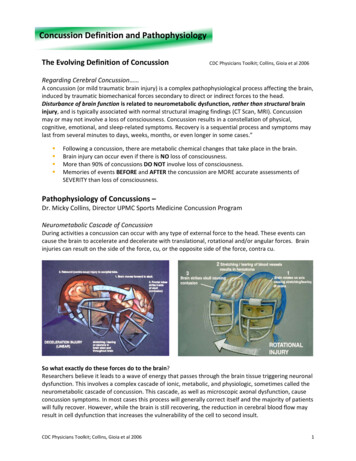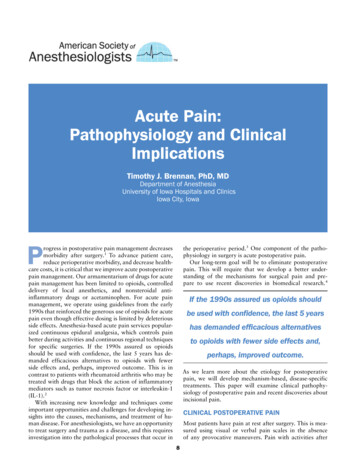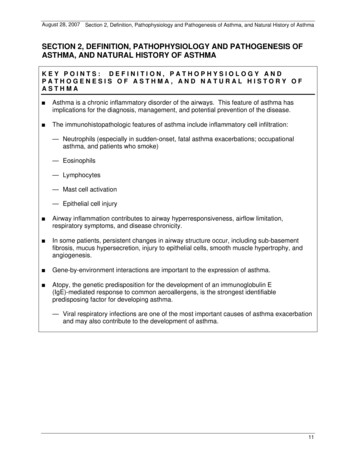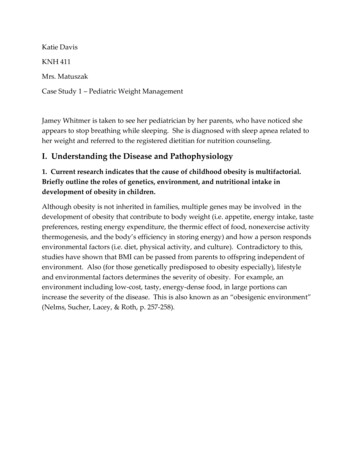
Transcription
Concussion Definition and PathophysiologyThe Evolving Definition of ConcussionCDC Physicians Toolkit; Collins, Gioia et al 2006Regarding Cerebral Concussion A concussion (or mild traumatic brain injury) is a complex pathophysiological process affecting the brain,induced by traumatic biomechanical forces secondary to direct or indirect forces to the head.Disturbance of brain function is related to neurometabolic dysfunction, rather than structural braininjury, and is typically associated with normal structural imaging findings (CT Scan, MRI). Concussionmay or may not involve a loss of consciousness. Concussion results in a constellation of physical,cognitive, emotional, and sleep‐related symptoms. Recovery is a sequential process and symptoms maylast from several minutes to days, weeks, months, or even longer in some cases.” Following a concussion, there are metabolic chemical changes that take place in the brain.Brain injury can occur even if there is NO loss of consciousness.More than 90% of concussions DO NOT involve loss of consciousness.Memories of events BEFORE and AFTER the concussion are MORE accurate assessments ofSEVERITY than loss of consciousness.Pathophysiology of Concussions –Dr. Micky Collins, Director UPMC Sports Medicine Concussion ProgramNeurometabolic Cascade of ConcussionDuring activities a concussion can occur with any type of external force to the head. These events cancause the brain to accelerate and decelerate with translational, rotational and/or angular forces. Braininjuries can result on the side of the force, cu, or the opposite side of the force, contra cu.So what exactly do these forces do to the brain?Researchers believe it leads to a wave of energy that passes through the brain tissue triggering neuronaldysfunction. This involves a complex cascade of ionic, metabolic, and physiologic, sometimes called theneurometabolic cascade of concussion. This cascade, as well as microscopic axonal dysfunction, causeconcussion symptoms. In most cases this process will generally correct itself and the majority of patientswill fully recover. However, while the brain is still recovering, the reduction in cerebral blood flow mayresult in cell dysfunction that increases the vulnerability of the cell to second insult.CDC Physicians Toolkit; Collins, Gioia et al 20061
In Normal Neuron Function the components of the neuron which include: the dendrites, nerve cellbody, axon, and synapse, are involved in a process in which a signal arrives at the neuron and the signaltravels down the axon to another cell, (at synapse) and neurotransmitters are released in an organizedmanner, triggering the next cell with a specific coded message. See below:CDC Physicians Toolkit; Collins, Gioia et al 20062
However, the Neuron During Injury releases its K (Potassium), which rushes out of the cell body andtoxic Ca2 (Calcium) ions rush into the cell, leading to metabolic dysfunction. See below:CDC Physicians Toolkit; Collins, Gioia et al 20063
Youth at Increased RiskAthletes of all ages, participating in sports, are at risk for concussion; 65% of concussions occur inchildren between 5 and 18 years of age. These children are at a greater risk for traumatic brain injury as the young brain of a pediatricathlete is still developing and tissue is not as able to recover as quickly as an adult brain.They are more susceptible to neurochemical and metabolic changes, their axons are not yet wellinsulated or myelinated, their cervical and shoulder musculature is less developed resulting in adecreased ability to absorb mechanical energy throughout their bodies, and they are less likelyto use proper techniques to reduce risk.All concussions are serious.The majority will recover within the first 3‐4 weeks.In some cases symptoms persist for much longer and 5‐10% last a lifetime.Until recovered, children should receive accommodations in all settings to promote cognitiverest.Signs and Symptoms CDC 2012CDC Physicians Toolkit; Collins, Gioia et al 20064
concussionsymptoms. In most cases this process will generally correct itself and the majority of patients willfully recover. However, while the brain is still recovering, the reduction in cerebral blood flow may resultin cell dysfunction that increases the vulnerability of the cell to second











